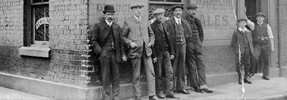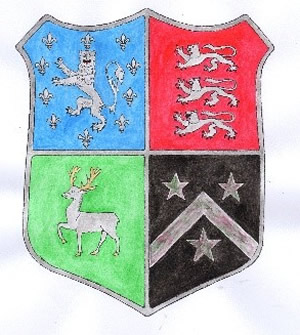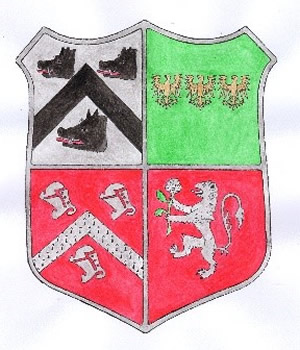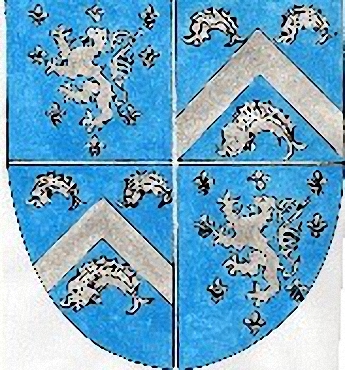Holland Family Coats of Arms by Brian Holland
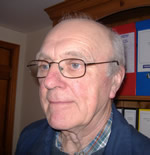
Historical Background
King Edward III founded the Order of the Knights of the Garter in 1348. The founder members were King Edward, the Prince of Wales Edward the Black Prince and 24 Knights who were considered to be the most prominent military leaders of the time. The founder members included Sir Thomas de Holland and his brother Otto de Holland of Upholland in Lancashire who had gained recognition during the battle of Crecy in France.
The first known reference to the Holland Coat of arms is mentioned in Bernard Holland’s “The Lancashire Hollands” page 30. The chronicler Froissart writing about the battle of Crecy in 1346 describes the coat of arms on the banner of Sir Thomas Holland as “The lion rampant, guardant, argent, on a field azure seme of fleur de lis” which his father (Sir Robert de Holand) bore in the lists at Stepney, this being a tournament that took place in 1307 outside London in the fields of Stepney.
The origin of this coat of arms is unknown; the presence of the fleur de lis on an azure field suggests a French connection. The only Holland known to have married the descendant of a prominent Frenchman was Sir Robert Holland son of Matthew de Holland who married Cecily Columbers, the great granddaughter of Philip de Columbieres of Normandy; however there is no evidence that he bore a coat of arms incorporating fleur de lis. The fleur de lis did not exist in French Heraldry before 1120 (A Guide to the Study of Heraldry, p12, JA Montagu). It seems unlikely that the coat of arms was generated much before the middle of the 13th century, perhaps by Adam de Holland of Eakaston or his father Sir Adam de Holland, Kt. As the names of their spouses is unknown it is possible one of them was of French origin, alternatively it could have been generated by Robert de Holland and adopted by his cousins by association
Regrettably there is no surviving evidence of the Coat of Arms of the Holland founder members in St George’s Chapel at Windsor Castle. It is believed that these were lost when the original chapel was replaced by the existing chapel. In the St George’s Hall of Windsor Castle the roof trusses are supported by buttresses in the walls; there are 26 buttresses under which are displayed the coat of arms of each of the founder members of the Order of the Garter. Those for Sir Thomas de Holland and Otho de Holland are identical and are as described in Froissart’s chronicle.
_svg.jpg) |
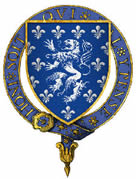 |
|
| Arms of the Kingdom of France | Arms of Sir Thomas de Holland 1st Earl of Kent |
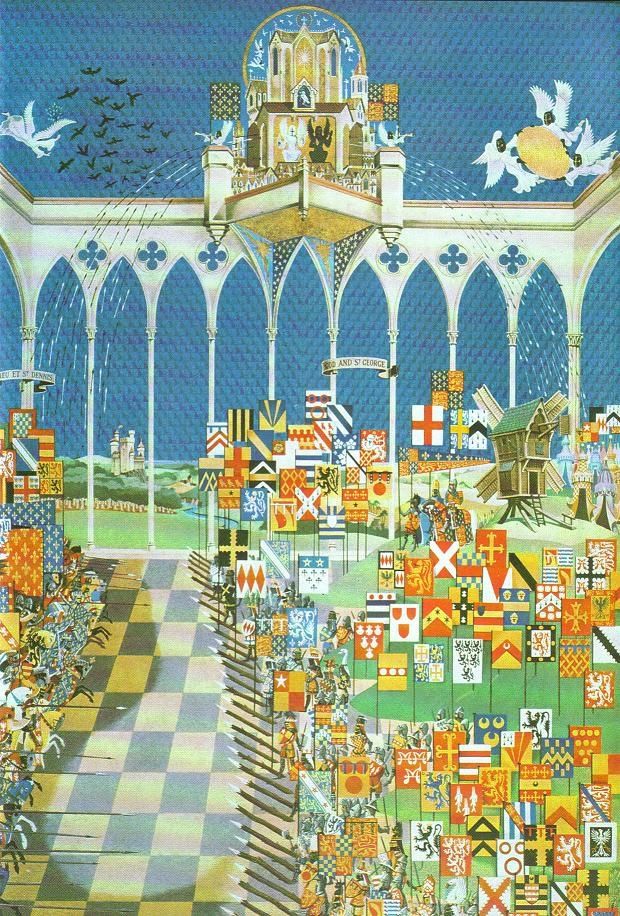 |
| The banners of the principal Knights and Nobles who fought at the battle of Crecy in 1346. The banner of Sir Thomas Holland can be seen in the centre, front row. (Painting by Dan Escott). |
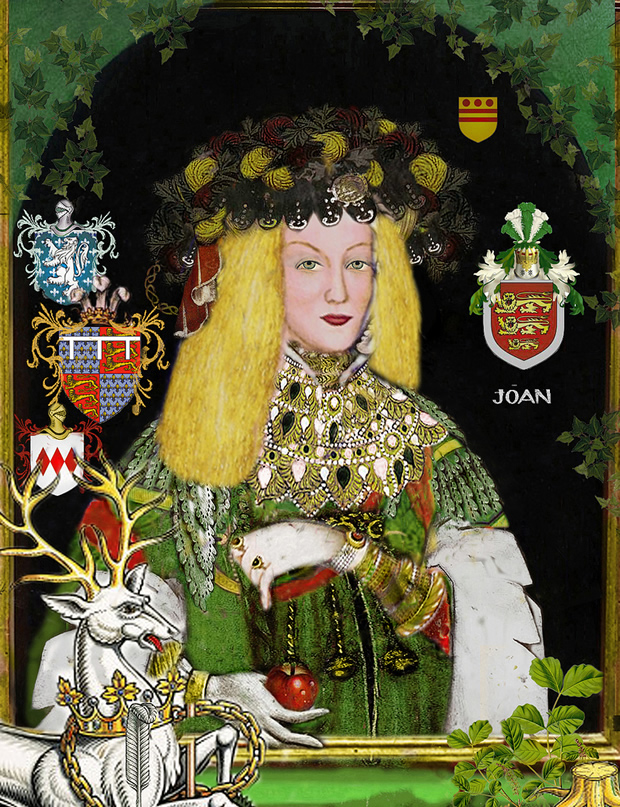 |
| Joan the Fair Maid of Kent |
The above portrait is that Of Joan the Fair Maid of Kent the wife of Sir Thomas Holland, Kt who she married after the annulment of her marriage to Montacute, Earl of Salisbury. After the death of Sir Thomas she married Edward the Black Prince and became Princess of Wales. The arms portrayed are:- bottom left Montacute, above Montacute are those of Edward the Black Prince, and above those are the arms of Sir Thomas de Holland. In the top right hand corner are those of her mother, Wake of Liddell and below this that of her father Prince Edmund of Woodstock.
Thomas Holland, Founder Knight
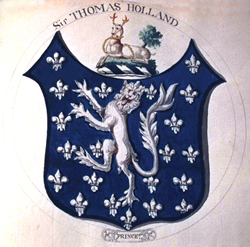 Thomas Holland, afterwards 1st Earl of Kent, was one of the founder knights of the Most Noble Order of the Garter.
Born around 1314, he fought many times in France during the Hundred Years War, including at the Battle of Sluys and the Siege of Tournai, and was in chief command of the vanguard at the battle of Crécy under the Black Prince. His military achievements meant that he was given important commands including the Captaincy of Calais Castle, guardianship of the Duke of Brittany during his minority, and in September 1360 his most important post yet, that of Edward III’s Captain and Lieutenant in Normandy and France.
Thomas Holland, afterwards 1st Earl of Kent, was one of the founder knights of the Most Noble Order of the Garter.
Born around 1314, he fought many times in France during the Hundred Years War, including at the Battle of Sluys and the Siege of Tournai, and was in chief command of the vanguard at the battle of Crécy under the Black Prince. His military achievements meant that he was given important commands including the Captaincy of Calais Castle, guardianship of the Duke of Brittany during his minority, and in September 1360 his most important post yet, that of Edward III’s Captain and Lieutenant in Normandy and France.
In 1340 he had secretly married Edward III’s cousin Joan, the “Fair Maid of Kent”. While he was away fighting, she was forced by her family to marry the better connected William Montagu, Earl of Salisbury. On Thomas’ return, the first marriage was revealed, and the Pope ordered Joan to return to Thomas. This she did, and they had four children together. In 1361, after Thomas’ death, Joan married the Black Prince, and gave birth to a son who would become Richard II.
The image (right) comes from a notebook by Henry Emlyn, architect and supervisor of George III’s restoration of the Chapel [SGC M.172]. Dating from around 1785, this page shows the arms of the Holland family, azure powdered with fleur-de-lis and a lion rampant argent. The crest of the hart lodged, or lying down, and ducally gorged comes from the arms of Joan of Kent.
Tags: Edward III, Henry Emlyn, Manuscripts, Order of the Garter, Thomas Holland
The above notes regarding Sir Thomas Holland are extracted from the Windsor Chapel Archives. Why these arms no longer appear in the Windsor Chapel Stalls is a mystery.
With the exception of Sir Thomas de Holland’s sons Sir Thomas Holland 2nd Earl of Kent and Sir John de Holland Duke of Exeter the majority of the other descendants adopted variations of the Azure, a Lion rampant, argent, guardant, semi fleur de lis. Variations included different numbers of fleur de lis and the lion rampant being countercharged (looking forwards). There are also variations in the crests of the different family lines. Thomas’s Sons Thomas and John chose to adopt variations of the Royal arms of their stepbrother King Richard 2nd and their mother Joan, daughter of Sir Edmund Woodstock, Earl of Kent.
.jpg) |
||
| Coat of arms of Richard 2nd | ||
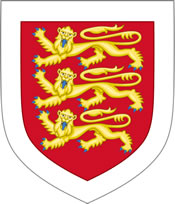 |
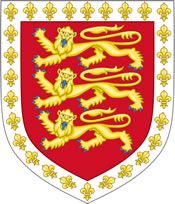 |
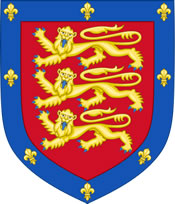 |
| Thomas Holland | John Holland | John Holland |
| 2nd Earl of Kent | 1st Duke of Exeter | 2nd Duke of Exeter |
From the evidence available, all of the Welsh Holland family lines have a variation of the arms of Sir Thomas de Holland derived from his father Sir Robert de Holland. In 1635 Sir Thomas Holland of Plas Berw, Anglesey, attempted to claim descent from John Holland, Duke of Exeter. Initially his claim was approved by College of Arms but this was successfully challenged as being incorrect and there is no evidence that any of his descendants adopted the arms of the Dukes of Exeter. This is described in more detail under the Anglesey Hollands. The fact the Eglwys Bach, Conway, Abergele, Kimnel, Anglesey and Llangelynnin Hollands all bore a variation of the Arms of Sir Thomas de Holland indicates a belief that they were descended from the Lancashire Hollands.
In the book "The General Armory of England, Scotland, Ireland and Wales" written by Sir Bernard Burk, King of Arms for Ulster and published in 1884 there are descriptions of the Arms of the different branches of the Hollands below. "The Development of Welsh Heraldry" by Michael Powell Siddons describes the Coats of Arms of the Welsh families named Holland from his research, which includes manuscripts and rolls, seals, and monumental inscriptions. A comparison of the arms of the English and Welsh descendants of the Hollands of Lancashire is carried out below.
England
Lancaster:
Temp King John (1199-1216); azure a lion rampant guardant between six fleur de lis argent. Presumably this refers in general to the Hollands of Lancashire.
(Ref: Burke’s General Armory, p499)
Denton.
These arms are given initially as being the same as those of Lancaster but were subsequently changed to azure, semi de lis, a lion rampant argent over a bend gules. This line descended from Sir Thurstan de Holland of Upholland via his son William de Holland who married Margaret de Shoresworth heiress of Denton, however their son Thurston de Holland of Denton was born when his parents were unmarried which may explain the introduction of the bend jules.
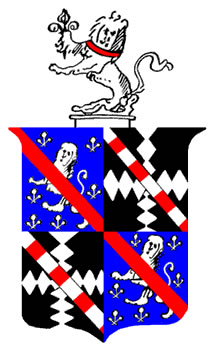
The arms of Holland of Denton (pictured right) are quartered with those of Kenyon. Quarterly 1 & 4 (Holland) Azure a lion rampant between a semee of fleur de lys argent overall a bendlet gules; quarterly 2 & 4 (Kenyon). Sable a cross lozengy argent overall a bendlet gabonated argent and gules. Richard de Holland of Denton born about 1325, d 1402 married Ameria d/o of Adam de Kenyon.
The arms of Holland and Warren in the Transept of St Lawrence’s Church, Denton are pictured below. These reflect the marriage of Thurston Holland born about 1390, grandson of the above mentioned Richard de Holland and Margaret d/o Sir Lawrence Warren of Poynton, chequay or and azure, on a canton a lion rampant, argent.
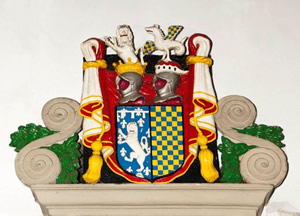 Arms of Holland and Warren
Arms of Holland and Warren
The Holland family were connected to the Barlow family of Chorlton-cum Hardy via the marriage in 1394 of Joan de Holland, daughter of Richard de Holland and his wife Almeria de Kenyon, to John (Jenkin) Barlow of Barlow Hall. Richard’s great-granddaughter, Elizabeth, d/o Thurstan de Holland and Margaret Warren married John de Reddich whose granddaughter Anne Reddish, d/o Otes Reddish, married Ellis Barlow, great-great-grandson of John (Jenkin) Barlow and Elizabeth Holland. Elizabeth, d/o William Holland, heiress of Denton married Sir Ralph Egerton whose descendants later bought Barlow Hall by auction in 1773.
Barlow Hall was modified in 1574 by Alexander Barlow, and the stained-glass windows depicting the Barlow coat-of-arms and those of their related families still exist (see below). The hall is now the headquarters of the Chorlton-cum-Hardy Golf Club (2017).
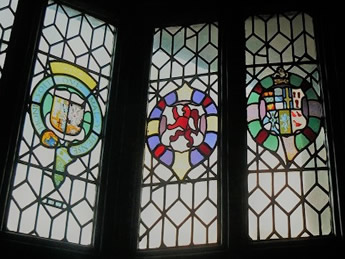 |
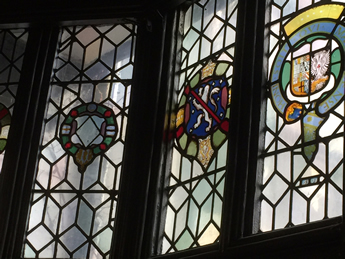 |
|
| Centre panel-arms of Reddish | Centre panel-arms of Holland of Denton (Photo Andrew Barlow) |
A pedigree showing the interconnection between the Hollands of Denton and Barlows of Chorlton-Cum-Hardy can be seen by clicking here. The families were close neighbours as Denton and Chorlton are about six miles apart as the crow flies.
An extended account of the Hollands of Denton is given in “The Lancashire Hollands” by Bernard Holland and "The Holland Family of Mobberley and Knutsford” by Edward Swinton Holland.
| This is the seal of the above mentioned Thurstan de Holland used on a document in 1439. | 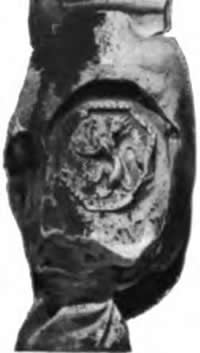 |
Clifton.
The arms are described in Burk’s General Armory as “a lion rampant, guardant between six fleur de lis argent” i.e. the same as those defined for Lancashire above. The Clifton branch was descended from Sir Thurstan de Holland of Denton via his son William. This coat of arms appears on a seal attached to a deed in 1361and belonged to William Holland of Clifton. In 1533, according to the Herald’s Visitation, the arms were quartered with a quarter sable, three maidens heads couped two and one, with a crest of a wolf passant shown as follows:
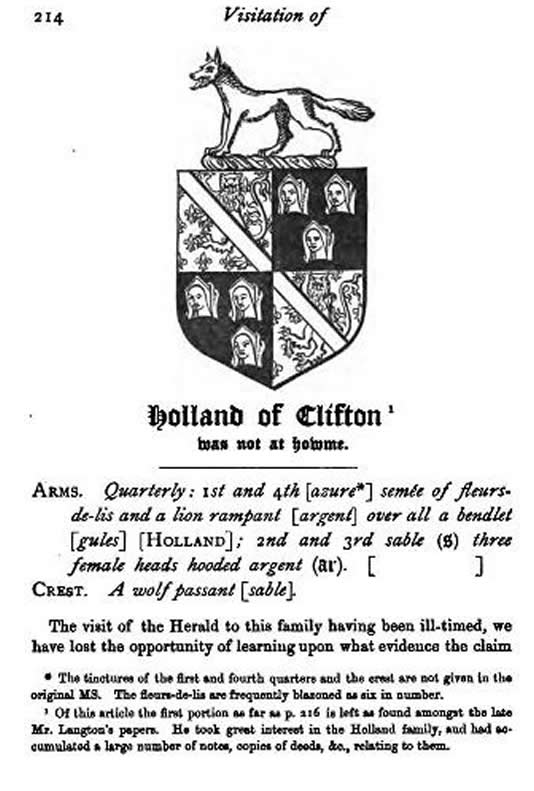 |
These arms were carved on the House of the Hollands of Clifton. It is believed that quartering and crest belonged to the family of Wolveley who once owned the Manor of Prestwich which was adjacent to that of Clifton. (Bernard Holland p287). Robert de Holland, grandson of William married Margaret d/o Thomas de Prestwich the son of Alice de Wolveley, so it is likely the ref carving came from this marriage. Clifton Hall went out of the Holland family in the early 17th century and was later rebuilt. St James Church Clifton was rebuilt in 1825; consequently we are unable to find any surviving monuments of the Holland of Clifton Coat of Arms in the Clifton Parish. The Clifton line continued in Mobberley.
Mobberley, Sandlebridge and Knutsford.
The Hollands of Mobberley, Sandlebridge and Knutsford are descended from the Hollands of Denton via William Holland b1605. (Lancashire Hollands p295). The arms of the Hollands of Sandlebridge are given in "The General Armory" as:- Holland (Sandlebridge, co. Chester, bart.). Per pale ar. and az. semée-de-lis a lion ramp, guard. counterchanged, debruised by a bendlet engr. gu. Crest - Out of a crown vallery or, a demi lion guard, per bend ar. and az. charged with a bendlet engr. counterchanged, holding in the dexter paw a fleur-de-lis also ar.
There are no arms given for the Mobberley line in the General Armory. In the book "The Hollands of Mobberley and Knutsford" by Edgar Swinton Holland the seal below is stated to be that of John Holland of Mobberley. The same book (p75) quotes the arms of Henry Holland, Lord Knutsford as:

Per pale argent and azure semee de lys, a lion rampant gardant, countercharged debruised by a bendlet engrailed gules.
Crest : Out of a crown vallery or, a demi lion guardant per bend argent and azure, charged with a bendlet engrailed countercharged, holding in the dexter paw a fleur de lys argent,
Supporters : On either side a lion gardant argent gutte de armes, the body charged with two fleur de lys in fesse between two bars engrailed azure.
Motto: Respice, Aspice, Prospice
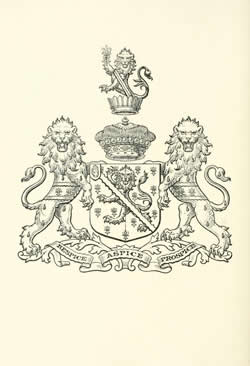 |
These arms are given in “The Visitations of England and Wales p 197 as being on record in the College of Arms and are portrayed as shown to the left. Henry Thurston Holland, Viscount Knutsford had two sons, Sydney George Holland became 2nd Viscount Knutsford and Arthur Holland who who changed his name to Holland-Hibbert by royal licence in line with the wishes of his maternal grandmother Emily Hibbert who decreed in her will that he should take the arms and name of Hibbert. The arms of Holland- Hibbert are given in the The General Armory as follows: Hibbert (Holland) -Hibbert, Munden House, Watford, co. Herts ; exemplified to Arthur Henry Holland, Esq., second son of Sir Henry Thurstan Holland, Bart., upon his assuming, by royal Licence, the additional surname of Hibbert). Quarterly, 1st and 4th, erm. on a bend nebuly sa. three crescents ar. in the sinister chief point a cross bottonee fitchee of the second, for Hibbert; 2nd and 3rd, per pale ar. and az. semee-de-Lys a lion ramp, guard, counterchanged, debruised by a bendlet engr. gu. Crests— 1st, Hibbert : In front of a dexter cubit arm erect ppr. vested az. cuff erm. holding in the band a crescent ar. a demi Catharine wheel also ar. ; 2nd, Holland : Out of a crown vallery or, a demi lion guard, per bend ar. and az. charged with a bendlet engr. counterchanged and holding in the dexter paw a fleur-de-lis ar. |
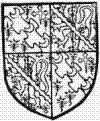 |
The coat on the left is that of Hibbert quartered with Holland. Also descended from Samuel Holland of Sandlebridge were the Hollands of Dumbledon & Eavesham, (Lancashire Hollands Appendix 1 B) whose arms are given in the General Armory as: “Holland (Dumbleton, co. Gloucester, formerly of Mobberley, CO. Chester; Edward Holland, M.P. for Evesham, High Sheriff co. Gloucester, 1842). Az. crusily a lion ramp. ar.” For some reason the fleur de lys were replaced by crosses (crusily) Edward Holland rebuilt Dumbledon Hall circa 1835, this is now a Hotel. It is not known whether there is a representation of his coat of arms within the Hotel or St Peters Church Dumbledon. There is a drinking trough monument to him in Dumbledon but no evidence of a coat of Arms. |
|
Sutton
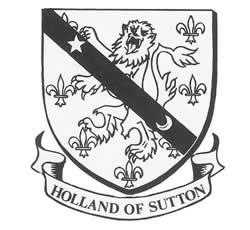 |
The Hollands of Sutton are directly descended from Richard de Holland s/o Robert de Holland s/o Matthew de Holland of Upholland. Their arms are given in the General armory as: There are no coats of Arms in the Church at Prescot relating to Holland. Sutton Hall, the family residence was burnt down in 1700 and subsequently rebuilt only to be demolished in 1935. There are no Holland arms in Prescot church which would have been their place of worship during their tenure. |
|
Lancashire miscellaneous.
These are the quartered arms of Francis, Viscount Lovel KG. as existing on the Lovel’s garter stall plate at St George’s Chapel, Windsor. (North Side Stall 17). The Lovel arms are quartered with those of Deincourt, Holand and Grey of Rotherfield. The Lovels inherited Upholland by virtue of the marriage of Maud (b1357, d1429) d/o Robert de Holand grandson of Sir Robert de Holand , 1st Baron Holand. By this marriage the Lovels succeeded to the Baronetcies of Holland and Lovel. |
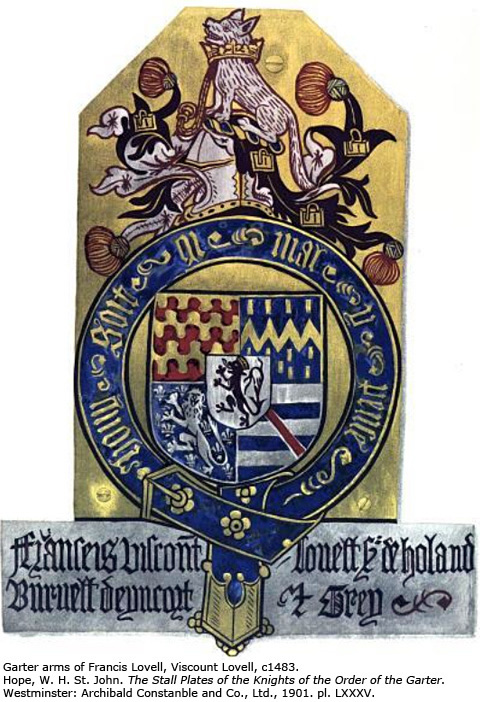 |
|
 |
This is a fireplace in Eastnor Castle, Herefordshire, which was commissioned in 1849 by John 2nd Earl of Somers. The arms a chevron inter three antlers of a stag, fixed to a scalp, are those of the Cocks family. The shield in the centre, immediately above the mantle is that of the progenitor of this family Thomas Cocks of Dumbleton who in the 16th century married Elizabeth Holland of Lancashire. I have so far found no data to identify the father of this Elizabeth Holland but she had the arms of the Upholland line as opposed to those of Sutton and their descendants. |
|
Cheshire.
The visitation of Cheshire 1580 and 1613 gives the following coats of arms referencing Holland:
Ravenscroft of Bretton quartered as follows:
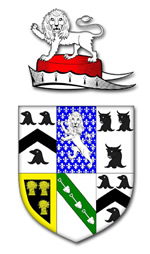 |
1 & 6-Ravenscroft. 2- Holland 3- Skevington 4- Brickhill 5-Swetenham. |
|
| Photo Courtesy Cheshire Heraldry | ||
Ralph Holland of Denbigh, Lord of Bretton married Rose d/o John Skeffington (Skevington). Their daughter Isabel married Hugh de Ravenscroft and their son Henry Ravesncroft was cousin and heir to Thomas Skevington. Ralph is said to be the son of Robert Lord Holland and his wife Maud (Powys Fadog Vol 3 page 110-111).
The following quartering is given in the Cheshire Visitation of 1580 for the family of Warren of Poynton. The Holland quartering comes about as a result of Isabell Holland d/o Robert Lord Holland who married John Earl of Warren. Also Robert Holland of Sutton married Agnes de Molyneux and Thurston de Holland of Denton married Margaret Warren.
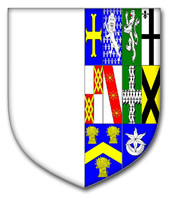 |
1 - Molyneux 2 - Holland 3 - Heaton 4 - Haydock 5 - Dutton 6 - Thoneton 7 - Kinsley 8 - Helsby 9 - Hatton 9 - Minshull |
|
| Photo Courtesy Cheshire Heraldry |
Norfolk
The Hollands of Quidenham, Norfolk are believed to be descendants of Brian Holland, Grandson of Thurstan Holland of Denton, however there is some controversy over this assumption.
In Vol 1 of The Topographical History of Norfolk there are some notes from George Holland of Croyland, Lincolnshire who lived between 1514 and 1568 that assume the Norfolk Hollands to be descended from the Lincolnshire line. He also assumed in his notes that Robert Lord Holland of Upholland was descended from the Hollands of Lincolnshire rather than from Thurstan de Holland as shown in other sources. The evidence supports the descent from Thurston de Holland of Upholland as portrayed in Lancashire Hollands Pedigree (page1).
The arms of the Hollands of Norfolk are given in the General Armory as follows:
Holland (Quidenham and Harleston, co. Norfolk, bart., extinct 1729). Az. semee-de-lis a lion ramp, guard, ar. Crest—A wolf pass. sa. charged on the breast with a mullet for diff.
The pedigree descending from Brian de Holland in the “ Topographical History of Norfolk, vol 1 page 344)” shows the following shield:
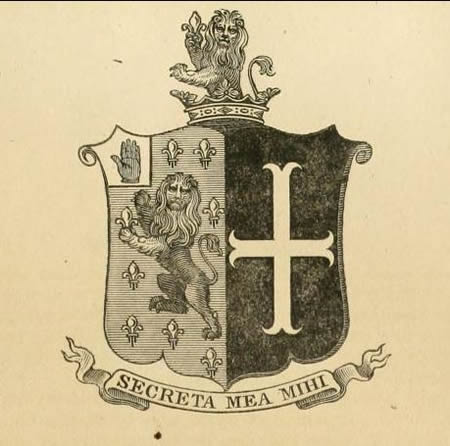 |
The Dexter half is similar to the Knutsford arms bur without the bend. The Sinister half is most probably that of Ann Warner wife of John Holland of Wortwell Hall and daughter of Robert Warner of Wingfield, Sussex whose arms ar given in the General Armory as “ vertical, a cross engraved, or”.
The following memorials exist in the church of Quidenham:
On a mural monument, at the north east end of the north wall, Holland impaling Panton, gul. two fesses erm. on a canton sab. a ferdumolin ar.
In Memory of the Merits of that excellent Person, the Lady Alathea Sandys, whose Bodie lyeth in the adjacent Dormitorie, is this Monument deservedly erected; she was the Daughter of John Panton, Esq. first married with William, Lord Sandys, afterward with Sir John Holland, by whom she had 6 Sons, and 5 Daughters, and with whom she lived happily 50 Years within 3 Months, and then in the 69 Year of her Age, upon the 22 Day of May, 1679, she Cheerfully rendred up her pious Soul to God that gave it.
Under this is an altar tomb covered with a black marble and pictured below;
Holland, Knevet, and Wigmore.
Here lyeth the Body of that Worthy Knight Sir Thomas Holland, who lived highly esteemed in his Country, and died the 5. of Febr. in the 48 Year of his Age, and in that of our Lord One thousand six hundred twenty and five, universally lamented.
On a black marble on the floor, by this tomb also pictured below;
Here lyeth the Lady Holland, the second Wife to Sir Thomas Holland, and Wife to Mr. Edward Barker, and buried in the Year 1648.
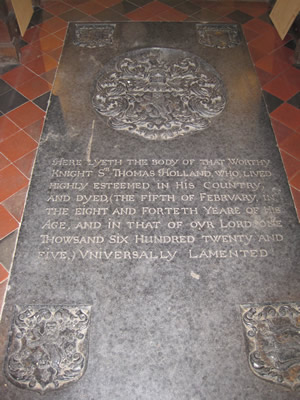 |
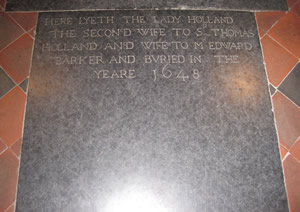 |
|
| Photos courtesy of St Andrews Church, Quidenham. | ||
On a mural monument against the north chancel wall, more west;
Holland and Panton.
Sir John Holland who erected this Monument for himself, 17 Years before his Death, maryed the Lady Alathea Sandys, he was sent a Commissioner from the Parliament to K. C. the First, and received Marks of Royal Favour, he lived an Honour as well as Benefactor to his Family, being Eminent for his particular Abilities and Integrity, and dyed 19th of Jan. 1700, after he was created Baronet 72 Yeares, and in the 98th Yeare of his Age.
Devon
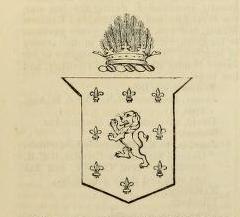 |
|
The arms of the Hollands of Devon are given in the General Armory as: Holland (Weare, Shipwash, and Upcott Avenel, co. Devon, descended from the marriage of John de Holland, a younger son of Robert, Baron Holland, with Elinor, dau. and heiress of Sir Andrew Metsted, Lord of Shipwash, 1314; the last male representative of the family, William Holland, Esq., of Upcott Avenel, left at his decease two daus., viz., Mary, m. Stephen Cobam, Esq., of Coham, co. Devon; and Margaret, m. John Coham, Esq., of Bovacott, CO. Devon). Az. semee-de-lis a lion ramp. ar. (sometimes or). |
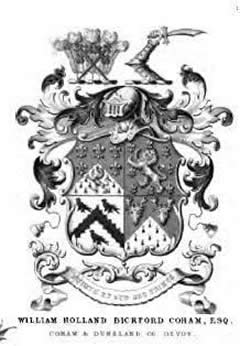 |
|
The arms of William Holland Bickford a descendant of the families of Holland, Coham Bickford are as follows: 1 Coham The family relationships are given in “A Genealogical and Heraldic History of The Commoners of Great Britain” (archive.org). |
Cornwall
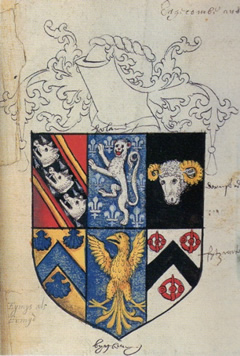 |
|
Piers Edgecumbe of Cotehele married Elizabeth Holland d/o Richard Holland s/o Thurston Holland of Denton. The Holland arms are featured in these quartered arms to be found in Cotehele House, Plymouth, Cornwall. 1 Edgecumbe
|
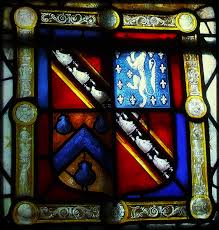 |
|
The stained glass window on the left quartering the arms of Holland and Edgecumbe can be seen in the Chapel of Cotehele House in Devon.
|
Staffordshire.
The history of the Holland family of Barton under Needwood is given in “Some Records of the Holland Family” written by an unnamed member of the family. (archive.org).
The family claim descent from Richard de Holland a descendant of the Holland’s of Upholland, Lancs who settled in Barton in the early 14th century.
The family did not feature in the visitations of Staffordshire or the General Armory, however in a letter from William Richard Holland of Barton to Walter Holland of Liverpool dated 1902, the author states “that his family have always claimed the arms of Holland, ancient, as given in the Calais Roll and books on Heraldry”. He goes on to refer to the arms in Conway Church showing a lion rampant guardant being representative. There are no arms in the Barton church or the neighbouring Church of Tatenhill, and regrettably the family home, Holland House, in Barton has been demolished.
Within the book on the Hollands of Barton there is a copy of a bookplate engraved by William Hogarth for John Holland the Heraldic painter. I have been unable to establish with any certainty a connection between this John Holland and the Barton family. The said John Holland served an apprenticeship in London with William Commins a painter stainer in 1706, the apprentice register describes his father as John Holland, Gentleman but gives no clue as to his origin. He died in 1760, in his will he leaves the majority of his estate to his grandson John Durant; presumably he had no male heir. He lived at Golden Head, Craven St, The Strand, London.
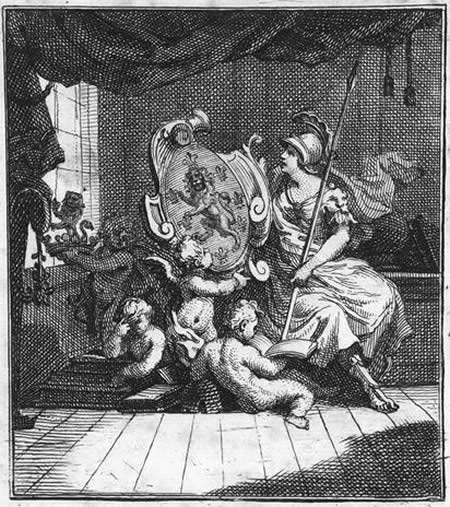 |
This Hogarth engraving was produced as a bookplate for the books of John Holland, Herald Painter. | |
Wales
In addition to the Hollands of Conway all the families descending from Roger Hoesgyn Holland i.e. Eglwys Bach, Kimnel, Abergele, and Llangelynnin bore similar arms to those of the Hollands of Lancashire and their descendants. References to these arms a given in The General Armory, The Development of Welsh Heraldry (Michael Powel Siddons), Powys Fadog, Archaeologia Cambrensis and other sources from Churches and family residences.
According to the Protheroe Pedigrees both the Conway and Roger Hoesgyn Holland lines descended from Adam de Holland in the late 12th century. This would imply that he was the progenitor of both the Welsh and Lancashire Hollands and bore the arms of “ Azure, a semi of fleur de lis, a Lion Rampant, guardant, argent” The earliest known reference to these arms is that of Sir Robert Holland in 1307, three generations later than Adam de Holland.
It is reasonable to assume that the Welsh Hollands would have known the origins of their descent to within three or four generations, especially as it was a requirement of Welsh inheritance that a potential heir should be able to quote his ancestral pedigree for at least seven generations. As Roger Hoesgyn Holland’s wife Margaret Chwith was a seventh generation descendent of Owen Gwynedd, Prince of Wales it is not unreasonable to assume that he would have been expected to quote his own pedigree for a similar number of generations. Whether the Welsh Hollands claimed their arms by direct descent from Adam de Holland or by association from Robert Holland of Lancashire who they believed to be a kinsman we don’t know, but the majority of evidence appears to support the latter assumption.
Eglwys Bach
Roger Hoesgyn Holland was the progenitor of all the Holland families in N Wales with the exception of Conway. He settled in the Eglwys Bach, Denbighshire in the second half of the 14th century having married Margaret Chwith a descendant of Owen Gwynedd. Roger’s descendants bore the arms of the Lancashire Hollands. In St Asaph Cathedral there is a memorial slab dating back from this period which has been assumed to be that of a member of the Holland family, as it depicts at one end a lion rampant in a field with three fleur de lis.
There is no way of knowing for sure whether this is a memorial to Roger Hoesgyn Holland, however it is quite likely that he would have been armigerous, and his status would have warranted a burial in the Cathedral. The image of the hare chased by a greyhound at the other end of the slab is probably symbolic and represents St Melangall the patron saint of the hair.
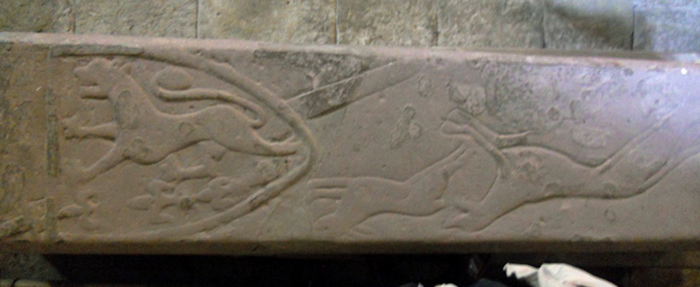 |
| Fourteenth Century Memorial Slab, St Asaph, Cathedral. |
There is no reference to the arms of the Hollands of Eglwys Bach in The General Armory or The Welsh Heraldry. The first reference is to that of Jeffrey Holland, of Eglwys Bach Esq., who was Sheriff of Denbighshire in 1563. The following reference to him is given in Archaeologia Cambrensis Vol XV, 1869 p16: “Jeffrey Holland of Eglwys Fach Esq., the son of Hugh Holland of Plas Y Pennant, Esq., and Alice his wife daughter of Robert ap Ieuan ap Meurig of Bodisilin in Anglesey, Esq., married Jane daughter of Ieuan Owen of Trebwll in the parish of Llansanfriad, Esq., ap John ap Robin ap Gruffudd Goch, Lord of Rhos”. Arms:- Azure, semi of fleur de lis, a lion rampant, guardant, or.
The gravestone of Jeffrey Holland of Pennant who died in 1797 is in St Martin’s Churchyard, Eglwys Bach, and features the Holland coat of arms as shown below:-
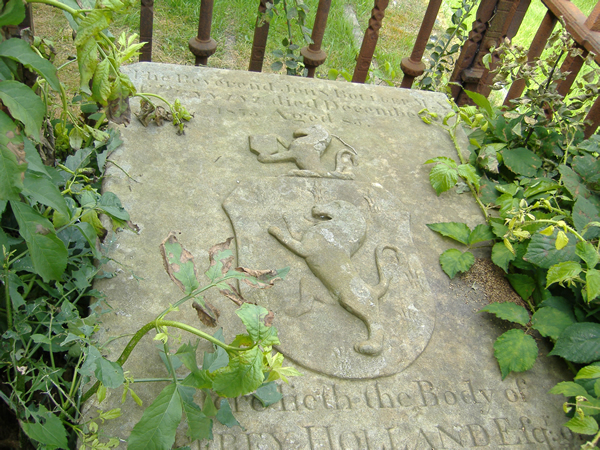 |
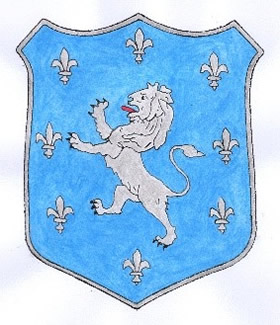 |
|
The Gravestone of Jeffrey Holland of Pennant who died in 1797. The Arms (above right) are the same as those described above for his ancestor Jeffrey Holland. Although not visible through ageing the fleur de lys are depicted as 8 in number to reflect the Arms adopted by Jeffrey Holland’s grandson Howel Holland Edwards. |
||
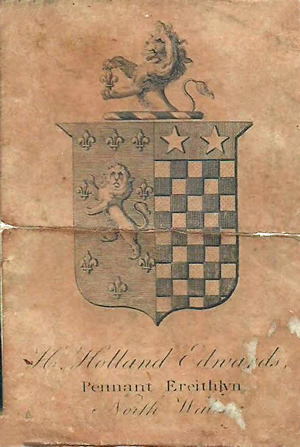 |
Jeffrey Holland’s grandson Howel Holland Edwards adopted the same arms to which he added those of his wife Catherine Palmer:- The arms of Howel Holland Edwards and Palmer. The old church of St Martin’s was demolished and rebuilt in the 19th century so any heraldry referring to earlier family members was presumably lost in the process. |
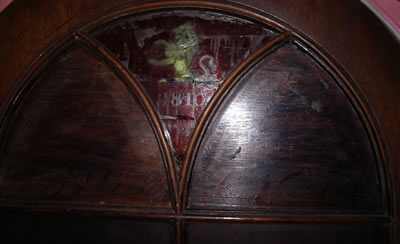 |
The adjacent heraldic feature is incorporated over the main entrance of Pennant. The date of 1810 indicates it was done during the tenure of Howel Holland Edwards. |
Kimnel and Abergele
The Abergele and Kimnel lines were descended from David ap Robin ap Hoesgyn Holland. Griffith ap David took possession of Faedref in Kimnel. His son David married first Joyce d/o Robert Knowsley, their son John inherited Faedref. David ap Griffith by his second wife Alice, d/o Sir William Griffith Kt., had a son William who took possession of Hendrefawr, a large farmhouse in Abergele. John ap Griffith of Faerdref had a son Piers who by his wife Catherine had a son David who inherited Faerdref and a son Humphrey who inherited Teirdan in the neighbouring Parish of Llaneilian Yn Rhos.
Faerdref and Kimnel
Y Faerdref was the demense farm of the manor of Dinorben Fawr in the Lordship of Denbigh. The first of the Holland family to occupy the property was Griffith ap David a grandson of Robin Holland and it was he who built the massive house which still remains. He married Gwerfil ferch Howel ap Madoc ap Ieuan descended from Collwyn ap Tango and may have acquired this property by this marriage. His grandson Piers acquired the Kimnel estate by his marriage to Catherine daughter of Richard ap Evan ap David ap Ithel Fychan who obtained the Kimnel estate via his mother Alice daughter and heiress of Griffith Lloyd.
A mansion house known as old Kimnel was built sometime after this marriage and was occupied by David ap Piers whilst Piers occupied Faerdref. The only reference to any coats of farms within these two properties appear in a book about Kimnel in the Llandudno Library referring to old Kimnel “ A royal Coat of Arms dated 1615 could still be seen at Kimnel in the 1930’s in Nestfields State Bedroom which had by then become a boy’s dormitory. The arms formed the centrepiece of the over mantel”. This may have been an attempt to gain kudos by affiliating themselves to the descendants of Sir Thomas Holland Kt, whose descendants bore the royal arms of their stepbrother King Richard 11. The Development of Welsh Heraldry describes the arms of the Hollands of Faerdref as:- A crest on a wreath argent and azure a demi lion rampant, gardant, argent, seme of fleur de lis, azure” and quotes Harl Mss 1971 folio 101 as the reference.
Regrettably the old church of St George was demolished and replaced by a new building in the mid 19th century so that any heraldic monuments have been lost. Mary vch David ap Piers Holland of Kinmel married William Price of Rhiwlas and his tomb in St Asaph Cathedral bears the arms “ Gules, a lion rampant argent: 2, a rose seeded, or, leaved vert; 3, vert a chevron arg, charged with 5 ermines between three nags heads erased of the second; 4,a griffin rampant gules.
Hendrefawr
William ap David ap Griffith Holland married Margaret daughter of Thomas Davies Bishop of St Asaph. It is believed that William built Hendrefawr which stayed in the family for six generations until lack of a male heir. There are two coats given in the Development of Welsh Heraldry for the Hollands of Hendrefawr. The first is the same as that of Faerdref and Kimnel from Harl MSS 1971. The second is “Crest a lion rampant, gardant, argent holding between his paws an oval shield azure, seme (de lis ?) argent, a bordure, or” The General Armory gives the arms as “Azure, a demi lion rampant, gardant between seven fleur de lis, argent”.
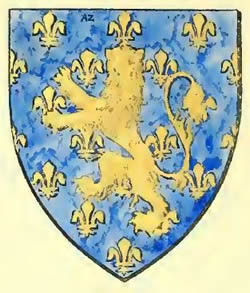 |
The heraldic shield portrayed in Powys Fadog for the Hollands of Hendrefawr and Teirdan. This Pedigrees from Powys Fadog vol 3, page 50 for Hendrefawr is illustrated by a similar coat of arms but with more fleur de lis.
|
T
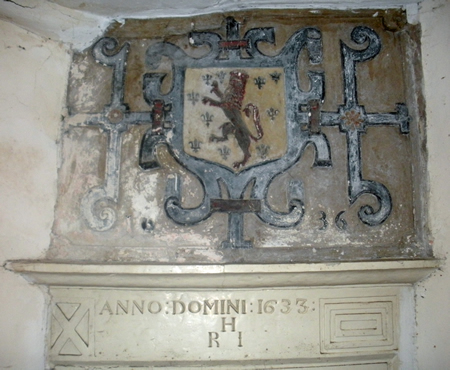 |
|
|
The coat of arms illustrated on the left appear over a fireplace in Hendrefawr dated 1633. This was probably commissioned by Roger Holland who was Sheriff of Denbighshire in 1630. |
||
Teyrdan (Teirdan).
Teyrdan is in the Parish of Llaneilian yn Rhos which is the neighbouring parish to St George, Abergele. Teyrdan came into the possession of Humphrey Holland the son of Piers Holland of Faerdref by virtue of his marriage to Agnes daughter and heiress of Rhys ap Dafydd ap Howel. It is not known whether there are any heraldic features within the property which is currently run as a family butchers specializing in rare breed meat. The following inscription appears in the stone lintel over the rear door:- “Delicias Habet Omnes Suas- Gaudia Tectum. (All the house has its delights and joys).
In the church yard of St Elians Church, Llaneilian yn Rhos there is an early 17th century sandstone chest tomb which has some interesting heraldic armorials carved upon the sides. The tomb is that of Humphrey Holland of Teyrdan who died in 1612; also interred within it are the remains of his son John Holland died 1654 and his grandson Thomas, died 1683
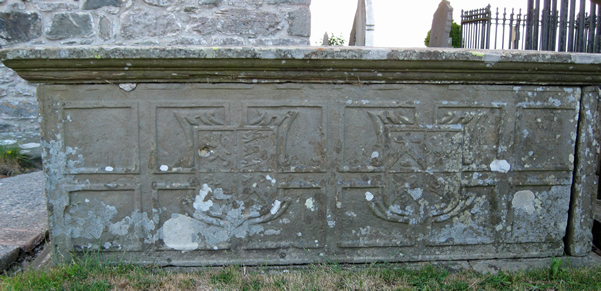 |
||
| Llanelian Church | ||
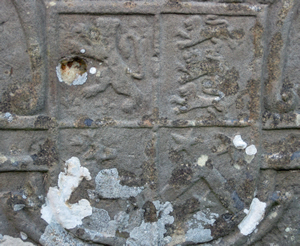 |
|
|
| Upper Left: The lion Rampant for Holland. Upper Right: Three lions passant. Lower Left a stag trippant, guardant. Lower right: A chevron between three mullets. | ||
|
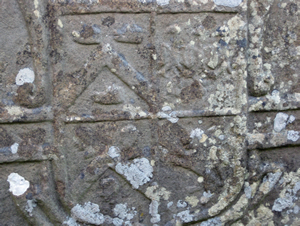 |
|
Upper Left: A chevron between three boars heads. Upper right: Three double eagles. Lower left: A chevron between three Englishmen’s heads. Lower Right, a lion rampant. The lion rampant here is not guardant so unlikely to be Holland. It may be that of Marchudd ap Cynan, Lord of Abergele from whom Ednyfed Fychan is descended. |
||
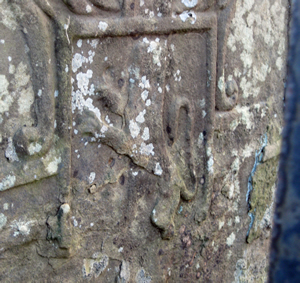 |
At the end of the tomb, A lion Rampant for Holland. | |
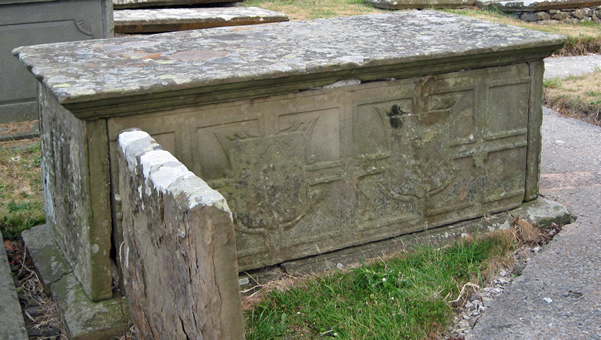 |
||
Shields 4 & 5 on the other side of the tomb are too eroded to be able to determine or distinguish the arms. |
||
In Arch Camb Vol XIII page 168 there is reference to the arms on the tomb of Humphrey Holland. These are basically as described above with the exception that it is suggested that the lion rampant in the 4th quarter of shield 2 is a leopard rampant and in shield 1 the mullets are incorrectly described as estoiles.
These coats of arms seem to be a collection of the arms of the Welsh Noble Tribes from whom the Hollands derived their estates by marriage.
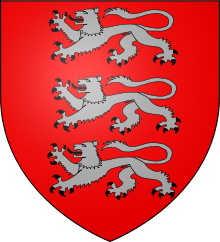 |
The three lions passant are possibly the arms of John Holland Duke of Exeter, being an attempt to associate this family with the royal lineage in similar fashion to their kinsmen who had the royal arms at Old Kimnel. Alternatively they could be that of Gruffudd ap Cynan whose descendant Ann vch Meredudd married Robin ap Roger Hoesgyn Holland. (P C B, Holland 1) |
|
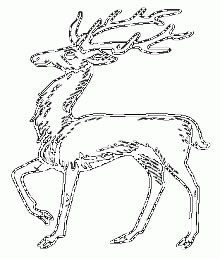 |
The stag trippant is probably that of Llywarch Holbwrch. According to P C Bartrum, Gruffudd ap Dafydd ap Robin ap Roger Hoesgyn Holland married three times, his third wife being a daughter of Gr ap Llw Gethin a descendant of Llywarch Holbwrch. | |
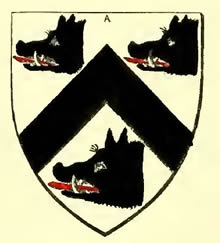 |
A chevron between three boars heads are the arms of Richard ap Ieuan ap Ithel ap David ap Ithel Fychan of Llaneurgain (Kinmel) descendent of the tribe of Ednowain Bendew. He was married to Alice vch Gruffudd Llwyd of Kinmael heiress of Kinmael. Their daughter Catherine, heiress of Kinmael, married Piers ap John Holland of Faerdref. (Powys Fadog Vol 3, p101-3). | |
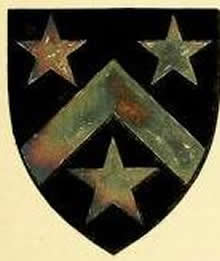 |
A chevron between three mullets was the arms of Rhys ap Robert of Kinmael, a descendant of Ednyfed Fychan, from whom Alice vch Gruffudd was descended. |
|
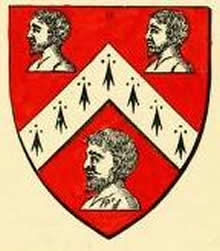 |
A chevron inter three Englishmen’s Heads were the arms attributed to Ednyfed Fychan, Seneschal of Gwynedd, who was the great great grandfather of Rhys ap Robert of Kinmael. The descendants and arms of Ednyfed Fychen are shown in the pedigree of Kinmael in Powys Fadog Vol 4, p 344. | |
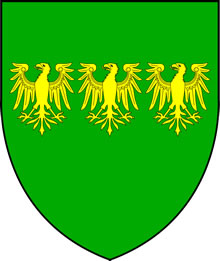 |
Three double eagles are the arms of Owen Gwynedd whose 7th generation descendant Margaret vch Dd Chwith married Roger Hoesgin Holland the progenitor of the Denbighshire Hollands. |
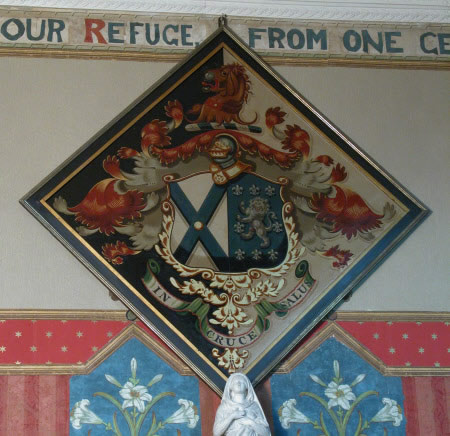 |
The Property of Teyrdan went out of the Holland family in the early 19th century due to the lack of a male heir, John Holland having died in 1804. His daughter married John Lloyd Wynne of Coed Coch and the Teyrdan estate went to him. John’s other daughter Margaret married Simon Yorke of Erddig which is now a National Trust property. The coat of arms of Yorke and Holland are displayed on the adjacent funeral hatchment and appear also above the fireplace in the Tribes room, on a pendant in the private chapel and on a silver tureen in the Chinese Room at Erddig. |
Anglesey- Plas Berw
The Plas Berw estate came into the hands of John ap Howel ap Robin ap Roger Hoesgin Holland by his marriage circa 1470 to Elen vch Ithel ap Hywel ap Llywelyn, heiress of Berw. There is no description of their arms in either the General Armory or The Development of Welsh Heraldry, the latter includes them with those of the families of Conway and Denbighshire. The earliest recognition that the family was armigerous is reflected in the fact that they were included in The Visitation of Wales by Llwyd Dwnn in the 16th Century.
There was a great controversy over the Coat of Arms of Sir Thomas Holland the Great, Great Grandson of John and Elin. It would appear that at one time he sought to bear the arms of John Holland, Duke of Exeter, rather than those of his immediate ancestors. This resulted in a challenge from the then Sheriff of Anglesey, Sir John Bold, and resulted in correspondence between Sir John Bold and Sir John Borough, Garter King of Arms, Sir Thomas Holland and his kinsmen, which eventually resulted in Sir Thomas’ acceptance that he was descended from the Hollands of Lancashire. He was eventually granted the right to bear the Arms of a lion rampant, guardant, argent between five flowers fleur de lis, argent with due difference.
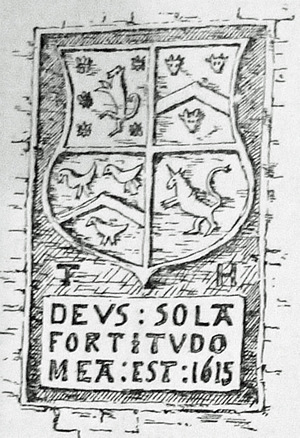 |
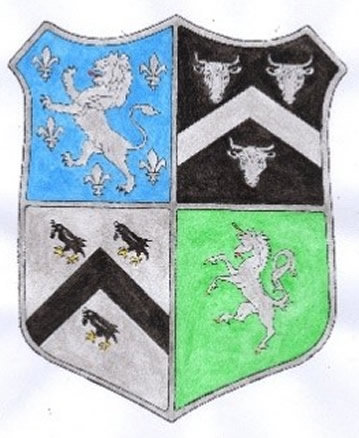 |
|
This whole business is a puzzle as can be seen by the sketch of a stone set into the wall of the mansion of Plas Berw pictured above left. (See “The History of Berw” written in 1861 by John Williams). The date of 1615 indicates that this slab was commissioned by Sir Thomas Holland, so at the time it shows that he believed that his arms were the lion rampant, guardant between five fleur de lis. The other arms are those of Bulkeley and the earlier owners of Berw. Sir Thomas was knighted in the year 1631 and it may have been this that prompted him to question his lineage. The correspondence relating to this issue is set out below. |
||
A letter from Sir Thomas Holland, Knight, to his nephew Mr Robert Wynn of Voylas, who was married to Thomas’ sister, Anne, concerning his family and arms, from a copy made by W W E Wynne, Esq. from the original letter pasted into vol 1 of Lewis Dwnn’s Heraldic Visitation of Wales.
“When I received your kynd letter, with Je’un Lloyd Jeffrey’s noat of my pedigree, I had then delivered all my papers to Mr Roland Whyte, who had undertook, with Mr Bulkeley’s help to Barronett Salisbury, to solicit my cause to Sir Francis Crane, assistant to my L Marshall in his Marshall’s court. He advised me to depart and leave him to deale ther because it concerned his brother Mr John Holland of Tairdun, so he answered why he solicited Sir Francis’ required sight of Sir John Borough’s letter to me. When he had redd it, and the pedigrees you sent me, and that from Griffith Hughes to me, he advised an appearance to be made in court, and not to go myself, and that I should write to Sir John and disclayme from the title of the duke, and insist on ther continuance of our name in Wales, never afore questioned; for our coat he will speak with myself at his return to Beaumaris , to be satisfied of my disclaymer from clayming the duke’s pedigree, and of my unfitness to travel; he thinks upon my appearance to discharge me and to allow my coat himself. Therefore send me forthwith the record you writ of Huskin in Edw. 3 tyme.
I am told there is a pardon recorded for 2 of the Hollands in Hen.4 tyme for the rebellion of Owen Glyndwr, it was for ther sevice done at Harleigh Castle. It appears upon the roule where all thos rebels were put to their fine in the p’gnathories office. Mr Pritherch gave me notice he found it and cannot suddenly find his note he took of it. He will search for it. Unless that be the record you have, therefore writ to me forthwith or send it me. I shall desire you to visit Baron Salisbury and by him and yourselfe possesse Sir Francis how many families were in Denbighshire, and my name. Deliver him a note of all the Holland’s houses in your shire, I pray you. Sir Francis is thought will return shortly. Jevan Lloyd Jeffrey’s noat is not proof without Mr George Owen’s booke. I expected you had labourd him for a noat under his hand , yf he do live, or hoped you would speak with him yourself, or labour for th’use of his book, and whole skill; yf he be dead and also the skill of Kayn. I pray you take payns yourself to help me with these things or the like forthwith. Whatsoever all things do cost you, I will upon your letter pay it with joyfulness and much thanks. I do not in this stand upon money.
I will provide a certificate to be subscribed by all my kinsmen, owners of houses to the name to Sir John Borough, yf I miscarry, they will all be questioned. D. of Exeter was created anno 22 Rich 2 (1398). I wish to be sure yf Mr George Owen, L Kemesh, was a deputy herald, or had warranted to display coats. Thom Shon Catty and Geo. Owen Harry had books and displayed coats. I am enformed of one Mr Vuchan by Dolgelly to be of great skill. I pray you to be enformed what can doe me good, and get what either of them but you alone. I was told that upon taking Rich 2nd in Conway Castle, Allen Holland fled and raised our family in Denbighshire. I think became a turner (changed sides). I think Mr Vychan will prove it. Get all under every mans hands and his own warrant to declare arms. This from Jevan Lloyd being proved I think good and true. I wish Harry will upon my charge go to Denton for a letter as I writ you to Quddnam to fetch his card (pedigree), though it differ somewhat from Jevan Lloyd’s, and his direction where to deliver it for him. I pray you see yourself Mr Roger Holland’s card (pedigree), and enquire if Piers Hollands may be seen. I desire doe quickly in these things, what you can doe, and visit Baronett Salisbury forthwith to prepare him, and again when Sir Francis cometh.
It is since the death of Hen.4, 220 odd years that pardon was by him granted, so it will therby apeare our continuance must be afor him. Our coat is one Lyon Rampant with five fleur de luces, in a blue field, and the Duke’s coat was 3 lions passant gardant o.; a border a semy fleur about the border, so set out by Mylin’s book in print, dedicated to Sir Robert Cecil, Earle of Salisbury in the late King’s reign, our then dread sovereign; so my discent cannot be from the Duke. Sir I marvayle that you writ not atall to me of the successe between brother David Lloyd and my good neice. I perceive he hath brother---- desir, and if you still constant--------- Prayers to God for your health and well doing in all things, doe take leave and rest Your assured loving unkle to dispose of in all I may
Tho Holland
Berw 14 Sept 1633
It is since the death of Hen.4., 220 odd years. He raigned 24 years 6 months lacking 10 days, so the name I believe bigan in Rich. 2 tyme, about his fall, in Denbighshire. I guess you know Dr. Wm. Griffith’s opinion, God dispose it to the best. I find in Thos:Myln’s booke, that Robert Holland, of Holland in Lancashire or Lyncolnshire, was common ancestor to the Duke; viz father to the first Thomas father to Tho:Holland, Rich 2 halfe brother. Robert’s coat was the lyon Rampt. The field semi floury. Tho: the son of Robert 3 lyons passant etc. and so all Earls and Dukes Holland, first Tho. made Earl of Kent ij Edw 3 tyme and of the garter.
To the worshipfull my deare nephew Robert Wyn Esq. Voylas his house.
Notes on the above:
Mr George Owen of Cemaes was a noted genealogist. Many of his MSS are preserved in the British Museum among Myfrian MSS.
Robert Wynne of Voylas was the son of Cadwalader Wynne and Anne Holland, Sir Thomas Holland’s sister.
John Holland of Teirdan was married to Dulcibella the daughter of Roland Whyte of Beaumaris.
Piers Holland of Kimnel was 1st cousin of John Holland of Teirdan.
Roger Holland of Hendrefawr was High Sheriff of Denbighshire in 1630.
There are several factual errors in this letter. It would appear that Sir Thomas did not have an adequate grasp of his direct pedigree having initially believed he may be descended from the dukes of Exeter as given in the pedigree submitted to the herald and reproduced in Lewis Dwnn’s Heraldic Visitation. This submission must have been given by Thomas’s father Owen Holland who was in residence at the time of the visitation, and is given as “Owen Holant ma bag aer Edwd Holand ma bag aer John Holant ab Howl ab Robin ab Hoesgyn Holand ab Roger ab Thomas ab Sir Thomas Holland marchog ab John Holland iarll Hyntington a Duwk of Exeter ab Edward Holland marchog ab Robert Holland marchog ag iarll Valencia.”
The assumption that the Welsh Hollands were descended from the Dukes of Exeter cannot be correct as their progenitor Roger Hoesgyn Holland was born approximately 25 years before John Holland 1st Duke and 50 years before John Holland 2nd Duke. This is pointed out in the footnotes below the Plas Berw pedigree in the Visitations. Also their ascent above Roger Hoesgin Holland differs from that shown in the Pennant pedigree in the same visitation, and was given as “Hoesgin Holland ap Roger Holland ap Thomas ap Sir Thomas Holland ap John ap Robert ap John Holland marchog (knight)”. According to this Pennant pedigree, Jeffrey Holland the incumbent of Pennant bore the arms of the Duke of Exeter, however there is no evidence of this in the Pennant papers.
It is interesting that the Kinmel pedigree only ascends two generations beyond Hoesgin,viz. Hoesgin ap Roger ap Thomas Holland.
None of these pedigrees agree with the Protheroe Pedigree which, viz. Hoesgin ap Roger ap Thomas ap Sir Thomas ap Ingelrham de Holland - and makes no claim of ascendancy from the Dukes of Valence. The following notes are transcripts of letters from the notes of John Williams, the author of The History of Berw from NLW MSS 1536.
Letter from John Borough to Sir Thomas Holland, 3rd March 1634:-
Sir
I understand that you do challenge unto yourself and give for your arms the Coat of the Duke of Exeter, which I suppose you would not do but upon good ground, yet because I am ignorant by what title you assume the same I desire you betwixt this and the next term to send me your claim and dissent that I may accordingly be resolved; whether they do of right appertain unto you or not of which I request you not to fail for according to your further trouble and charge do I rest.
Your loving friend
John Borough, Garter, Principal Knight of Arms.
Letter from unknown member of the Holland family, probably one of those from Denbighshire mentioned in Sir Thomas Holland’s letter:-
Worthy Sir,
Being given to understand how Sir Thomas Holland of Anglesey, Knight, is called in question concerning his pedigree (???. We that are of the same family, descending of the same line, think it fit to certify unto you what we ever conceived and hath been recited successively in the memory of man to be our right, first our descents in Wales in diverse (muses), as we are well able to make it appear unto you, is between three hundred years afore being gentlemen of good name and quality who from time to time have given for their Coats Azure a lion Rampant with five Fleur De Lises: this which in the memory of man was never questioned before. Whereas it is considered that we assume the Duke of Exeter’s Coat, that we absolutely wave, challenging no more but what belongs to the Hollands of Lancashire, from whom as we assume it we are linearly descended. But in all this we do (defer) to your better judgment (???).
Yours ----
???1635.
The three hundred years referred to puts the immigration of the Lancashire Hollands into Wales at approx 1365 which is consistent with our assumed birth date of 1330 for Roger Hoesgin Holland.
The assumed birth date for Roger Hoesgin Holland of 1330 which is achieved by extrapolating upwards from known birth dates of his ancestors, and downwards 7 generations from Owen Gwynedd to his descendant Margaret vch Dafydd Chwith, the wife of Roger Hoesgin Holland.
The following letter is from Mr William Bold, sometime Sheriff of Anglesey to Sir John Borough (Arch Camb. 1868 p 126). The Bold family originated in Lancashire and was a neighbour of the Hollands of Upholland:-
Worthy Sir
Give me leave, I pray you, to aquainte you with my proceedings in these parties; being desirous to understand Sir Thomas Holland’s descent, for yr better satisfaction, of some conference I obtained to see his evidence; where I found that in these parts his ancestors formerly had beene powerfull men, but in te time of Henry the 4th, Henry 6th, Henry 7th and Henry 8th and so to these tymes for their coate they have not been such curious preservers of it, or at least it appears so unto me as I have direct proofe of it. Only they receive it by tradition from tyme to tyme preserved by our antiquaries and gentlemen curious in pedigrees. Nor do I find that the rest of his family derive themselves from the Duke of Exeter but from the Hollands of Lankeshire, wch in all likelihood may be soe, for in those turbulent tymes , I find that manye Englishe out of Cheshire and Lankeshire were transferred heare to places of Judicature and keeping of forts:wch I might very well instance my own name as in the Pickmen, Spicers, and many others; I find his error to be that being on a sudden called on he relayed to much on Mr Hughes your officer’s knowledge , not sending, as he ought to have done, to the rest of the family; but now, upon conference with them he waves Mr Hughes opinion; I dout not but to give you satisfaction therein; and soe desirous he is of it that in person he intends as I hear say to do it. My cousin Jo; Griffith presents his love and service to you, and both of us doe joyntlie intreat you that there may be noe proceedings against him till one of us come to towne, whiche, God willing, will be shortlie this terme.
William Bold.
The final correspondence in the series was the letter patent written by John Borough which records the Granting of the arms of the Lancashire Hollands with due difference and is recorded in the introduction to the Visitation of Wales, volume1:
I shall close these remarks by the insertion of the following authentication of the arms of the Holland family, whose pedigree is given in volume 2, page 364 (Pennant, Eglwys Bach), taken from one of Mrs Madock’s before mentioned volumes, in the handwriting of George Owen. But this, with some other additions, is by a more recent hand:-
“ To all and singular unto whome these presents shall come, John Borough, Knight, Garter Principall King of Armes sendeth greeting:
Upon complaint made unto me that Sir Thomas Holland of Berrowe, in the county of Anglesey Kt did unduly beare for his armes, Azure a lyon rampant gardant between five flowers de lis Argent, which armes (as was conceived) properlie belonged to the family of Holland sometime Duke of Exeter: The said Sir Thomas Holland having notice given him of ye said complaint repayed unto me, and produced divers and sundry auncient Evidences, Pedigrees, Bookes of Armes, Letters patent and other authentique testimonies of credible persons: whereby it manifestly appeared that the said Sir Thomas Holland is lineally discended from Hoshkin alias Roger, who by computation of time lived in or near the reign of Edward the Third (1327-1351).: He the said Sir Thomas being the sonne of Owen, sonnne of Edward, sonne of Owen sonne of John sonne of Howell sonne of the above named Hochkin Holland: And that John Holland sonne of Howell Holland aforesaid was household servant to King Henry the sixth: And Owen Holland great grandfather of the said Sir Thomas was Sheriffe of the County of Anglesey for terme of life, as by Letters Patent under the Seales of King Henry the Seventh and King Henry ye Eighth and certain deeds of Charles Brandon Duke of Suffolke, and other muniments appeareth: And further that by sundry matches and marriages the said Sir Thomas is allied to many families of undoubted gentry, in and near the said county, who acknowledge the said Sir Thomas for their allie and kinsman: besides ye testimony of divers gentlemen of the name of Holland issued from the aforesaid Hochin alias Roger their common ancestor: And as touching the Armes above mentioned , it is manifest by sundry Pedigrees and Bookes of Armes remaining in the custody of George Owen Esquire, Yorke Herald that the Ancestors of the said Sir Thomas Holland did beare the same as they are above blazoned. In consideration of all wrt premises, and for that the said Sir Thomas Holland is not only dignified with Knighthood, bur likewise a Justice of Peace and one of the Deputie Lieutenants in the County where he liveth: I have thought fit at his request to signifie and declare by these presents that the said Sir Thomas Holland and his heires of that family respectively may use and beare the aforesaid Armes.
In Witness whereof I have hereunto affixed the seale of mine office and subscribed my name.
In the five and twentieth day of November in the eleventh yeare of the reign of our Sovereign Lord Charles by the Grace of God, King of Great Britain, France and Ireland, Defender of te Faith etc. And in the yeare of our Lord God 1635.
John Borough
Garter Pricipall King of Armes.
This letter appears to suggest that Sir Thomas Holland had mistakenly assumed that the arms of the Duke of Exeter were those of his ancestors, i.e. the lion rampant guardant, azure semi of fleur de lis. It is surprising that he sought help from the Hollands of Kinmel and Abergele rather than those of his nearer kinsmen of Eglwys Bach. Perhaps the Abergele and Kinmel families were more into Heraldry than The Eglwys Bach line as evidenced by the ornate tomb of Humphrey Holland of Teirdan in the churchyard of Llaneilian Church commissioned shortly before the above controversy. (See above).
There was a wealth of genealogical information provided in support of Sir Thomas’s claim; however none of this seems to have survived. There appear to be no family Plas Berw papers in any of the archives, and nothing of the data presented to John Borough exists in the College of Arms.
There are no known surviving monuments of the Hollands of Berw inspite of their high status within the county of Anglesey. Plas Berw still exists as a listed building but the churches of Llanidan and Llanfihangel Eskeiviog are now derelict.
It is likely that the Arms of Holland and Bulkeley were quartered and these may have existed in the Bulkeley family mansion of Baron Hill. Regrettably this mansion house is now derelict.
Conway, Caernarfonshire
Bernard Holland in his book The Lancashire Hollands assumes that the Conway line descends from Alan de Holland a brother of Robert De Holland, 1st Lord Holland, who was born circa 1280 and was beheaded in 1328. This assumption is repeated by Sir Thomas Erskine Holland in his book the Hollands of Conway which goes on to say that John Holland, son of Alan de Holland married Edith co-heiress of Stephen Sutton in 13 Edward 111 (1339- 40) and as a result quartered the arms of Holland, Sutton, Travers and Norris. He then goes on to say that the descent from John and Edith was Alan, Peter, Robert, Peter. Assuming 30 years per generation this would imply that Peter was born circa 1459 which is a hundred years later than his assumed birth date if circa 1345 which is achieved by extrapolating upwards from known birthdates of his descendants and confirmed by the fact that he served in the household of Henry 4th 1399 -1412.
The more plausible scenario is that shown in the Protheroe Pedigrees which shows the Conway line descending from Alan de Holland the 4th son of Sir Adam de Holland of Eakaston who was born circa the end of the 13th century and far better fits the time line. This Alan de Holland is given as the brother of Ingelrham de Holland the progenitor of the Denbighshire Hollands.
The Heraldic Visitations only show the pedigree emanating from Humphrey Holland, the great great grandson of Piers Holland and gives no indication of his ancestry. The General Armory gives the arms of the Conway Hollands of Sussex as “az, semee-de-lis, a lion rampant, guard, ar. Crest:- out of a flame ppr, an arm issuant, habited in a close sleeve sable, the fist ppr holding a lions gamb barwise erased or., the talons to the sinister side. Motto:- Fiat pax, floreat justitia”.
There are two entries in The Welsh Heraldry by MPS:-
“ Azure, semi de lis, a lion rampant, guardant, argent” from the tomb of Hugh Holland in Conway Church.
Quarters 1 to 6, Holland, Sutton, Travers, Norris, Bulkley, Holland.
Crest:- Out of a flame of fire proper an arm issuant habited with a close sleeve sable, the first proper holding an eagles leg barways erased, the claws to the sinister side.This is similar to that in the general armory.
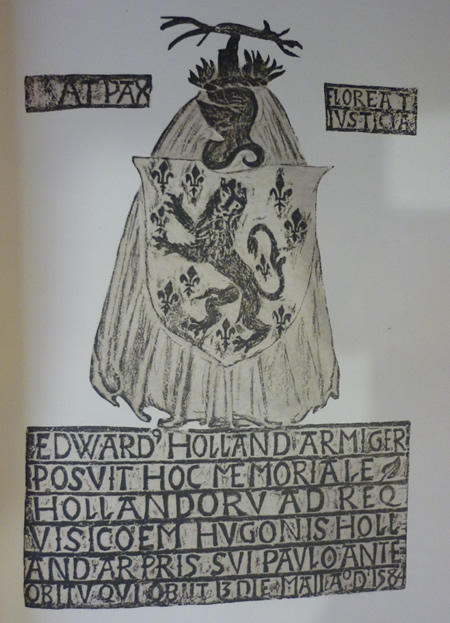 |
The monument to Hugh Holland (d1585), in St Mary’s Church, Conway, erected by his son Edward Holland, Armiger as described in the Welsh Heraldry. |
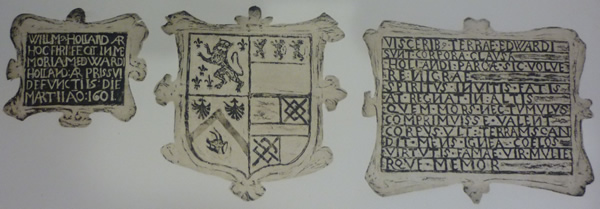 |
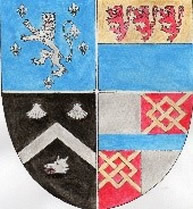 |
|
| The Quartered arms in Conway Church, not quite as described by MPS in the Welsh Heraldry. Quarter 1 is Holland; quarter 2 is Sutton, quarter 3 is Norreys (Norris) of Speke and quarter 4 is Travers. | ||
In the general armory the only Travers bearing these arms is of Netby in Co. York, sable a chevron argent, between in chief two escallops and in base a boar’s head of the second. These arms reflect those attributed to John Holland of Hale in Lancashire son of Adam de Holland of Eakaston. According to the Protheroe Pedigree John Holland married Elizabeth daughter of Stephen Sutton and his arms are described as “quarterly 1 and 4, azure on a chief of three swifts gules; 2nd sable on a chevron inter 2 escallops in a chief and in a boars head couped, argent, Travers; 3rd argent t and gules a frett or, a fesse or, Norris. The Protheroe Pedigree is repeated in the Advenae of Caernarvonshire in the Golden Grove Book of Pedigrees. (ref- gti.org.ukgolden grove.)
The Visitation Of Lancashire taken in 1567 states that “Alan Norreys of Sutton(circa 1150) descended out of the house of Sutton in the same county as appeareth in a deed without date”. This may explain the existence of the Norreys and Sutton quarterings on the above shield; however the connection to Travers is so far a mystery. The quartering of arms did not generally appear before the mid 14th century which suggests that they were added retrospectively to Elizabeth Sutton. The main line of Hollands in Conway ended with the deaths without issue of Hugh and William the sons of William Holland of Conway and Marle in the mid 17th century.
Their sister Margaret married William Williams and their son was named Holland Williams; his descendants assumed the name of Holland until the decease of Owen Holland in 1795 when the male line was extinct. From the Conway Parish Registers it can be deduced that there were two other lines of Holland descending from their common ancestor Humphrey Holland. One of these was extinct in the male line with the death of David Holland in 1634.The other was extinct with the death William Holland in 1683 son of William Holland who died in 1667.
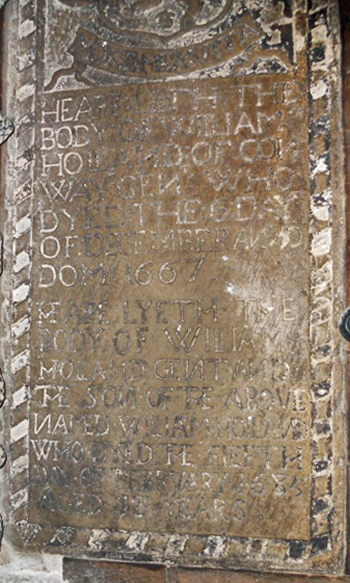 |
Their gravestone which can be found in the floor of Conway Church has the complete Coat of Arms Holland. “Hear lyeth the body of William Holland, Gent who dyed the 6 day of December Anno Dom 1667, Here lyeth the body of William Holland Gent and son of the above William Holland who died the tenth day of February 1683, aged 18 years." |
|
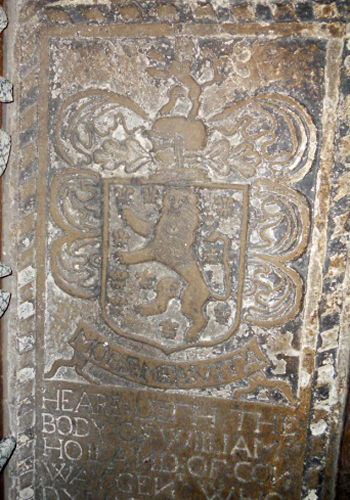 |
||
Llangelynnin, Caernarfonshire
This line is believed to be descended from the Hollands of Eglwys Bach. We know that it was armigerous as Owen Holland of Llangelynnin was referred to as Gent in a deed dated 1597 and Humphrey Holland sealed a deed dated 1694 with his seal which had the Arms of Holland quartered with Those of Trahairn Goch.
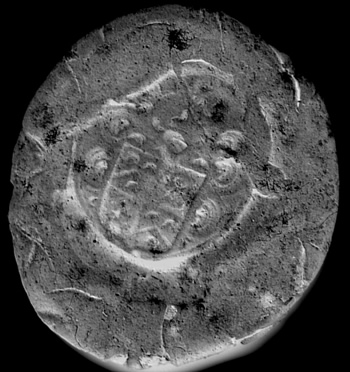 |
|
|
An impression of the seal of Humphrey Holland on The Deed Coed coch 528 is shown top left. This is referred to in The Welsh Heraldry as “a lion rampant a bordure engrailed. Crest On a helm on a wreath a lion rampant.” and is recognized as being different to those of Berw, Abergele etc. There is no evidence of any fleur de lis, however as can be seen from the photograph the seal is very small and it is very difficult to discern the actual detail. An image of the Arms as described in The Welsh Heraldry can be seen above right and reflects how the seal would appear when impressed in a wax seal on a letter or document (see below). |
||
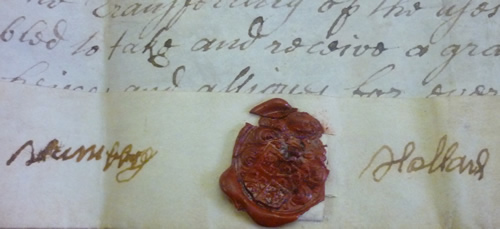 |
||
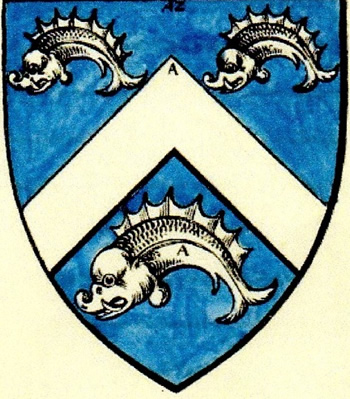 |
The arms of Trahairn Goch as included in the 2nd and 4th quarters of the seal of Humphrey Holland. The most likely source of these arms are from the marriage of Humphrey’s father John Holland’s marriage to Gaynor vch Robert Griffith in 1627 (Conway P R’s). He may have been a descendant of the Griffith family of Cefn Amlch, Lleyn, who bore these arms, there is no evidence in the Conway P R’s that his ancestors were from Conway. |
|
Lincolnshire
In the Heraldic visitation The Arms of the Lincolnshire Hollands are given as Party per pale indented or and gules. This is repeated in the General Armory “per pale indented gules and or”. These arms are also given for Holland of Siston, Gloucester. Also the arms are quartered with those of the Hollands of Lancashire for Holland of Stevington, Co Lincoln and Kinton Co Nottingham: “per pale indented or and gules, quartered azure, semee of fleur de lis, a lion rampant, guardant, argent”. Crest a sinister wing, or. The general Armory also gives for Co Lincoln “ Barry bendy of eight gules and or”. The Visitation of Lincolnshire also has the “azure, semee of fleur de lis, a lion rampant argent as a second coat of arms. This has probably come about by the belief in some sources that the Hollands of Lancashire descend from Robert Holland of Swineshead s/o John s/o Ingelrham and that this was Robert 1st Baron Holland who married Maud de La Zouche. This claim is refuted in other sources and documentation exists that shows that Robert Holland of Swineshead married Joan d/o Sir Baldwin de Tyas (Teutonick) who later married John de Byron.
This note appears in the Lancaster Final Concords p 136 “Baldwin de Tyas acquired a considerable estate in the parish of Rochdale by his marriage with Margery, daughter of Hugh de Eland, and widow of Gilbert de Notton. The estate lying in Butterworth, Clegg, Gartside, Ogden or Okeden, Hollingworth and Haugh, was bestowed by Baldwin upon Robert de Holland (not of Up-Holland) in frank marriage with his daughter Joan la Tyase (Dodsworth MSSlx111, f 53). After the death of Robert without Issue, Joan married John de Byron conveying these estates into that family) Ibid). The Holland Pedigree in the Lincolnshire Visitation lacks credibility in that there appear to be too many generations between John Holland the supposed grandfather of Ingelrham de Holland living in 1209 and the known birth date of his 13th generation descendant Thomas Holland of Estovening. This misunderstanding is repeated in the Devonshire Visitation Pedigree. The more likely scenario is that contained in the Protheroe pedigree which has a more plausible timeline. So far I have found no surviving examples of the original Coat of Arms of the Hollands of Lincolnshire. Also I can find no marriage to explain the quartered arms of the two families.
Summary
The development of Heraldry evolved as the practice of tournaments between knights developed in the 12th and thirteenth centuries. It became necessary for knights to obtain a license to compete and eventually in the 13th century a coat of arms was a prerequisite to participation as a means of identification. Tournaments were banned by Henry 2nd in the late 12th century and reinstated by Richard the 1st in 1194. The origin of the Holland coat of arms is unknown but could have started with Sir Adam de Holland, Kt in the 12th century. The Protheroe pedigree attributes the arms, azure, semee de lis, a lion rampant, guardant, argent to him although we don’t know whether this was a retrospective allocation. These same arms appear in the tournament lists at Stepney in 1307.
The arms of Sutton, Travers and Norris are quartered for the wife of John Holland of Hale, the great grandson of the above mentioned Sir Adam de Holland in the early 13th century (Protheroe Pedigree). It seems likely that the three lines of Holland descending from Adam de Holland of Eakaston, the son of Sir Adam de Holland, Kt bore the same arms. Sir Robert de Holland the heir to Thurstan de Holland of Upholland retained the basic Holland arms, whilst Sir William de Holland another son of Thurstan de Holland, and his descendants, incorporated a bend, gules to differentiate themselves from the Upholland line. Sir Thomas Holland, Earl of Kent, and his brother Otho de Holland, founder members of the Order of The Garter, also bore the basic Holland arms, whilst the sons of Sir Thomas Holland, Thomas and John, and their descendants adopted the royal arms of their stepbrother Richard 2nd. The Conway and other Welsh lines descending from Roger Hoesgyn Holland both retained the basic Holland arms.
To differentiate between the family lines there are variations in the number of fleur de lis and type of crest. The existence of the quartered arms of Elizabeth Sutton in Conway Church, ads credibility to the Protheroe Pedigree regarding the descent of the Conway Hollands. The arms were probably added in the 16th century at the same time as the monument to Hugh Holland, and indicate an awareness of their descent from John Holland of Hale. The correspondence involving Sir Thomas Holland of Berw in Anglesey and the response from John Borough, Garter, Principal Knight of Arms, confirms the descent of the Denbighshire and Anglesey lines from Roger Hoesgyn Holland living in the 14th century. His great grandfather was Sir Thomas Holland, Kt living in the reign of Henry 3rd, so it is probable that he also bore the Holland arms. The evidence from the coats of arms found to date appears to support the Protheroe Pedigree as the most likely depiction of the descent of the Lancashire and Welsh family lines. It is interesting to note that the Eglwys Bach, Berw & Llangelynnin Holland arms feature a Lion Rampant counterchanged (looking forwards) whereas the Lancashire, Conway & Abergele/Kinmael lines feature a Lion Rampant Guardant (looking outwards).
The descent of the Lancashire Hollands from the Lincolnshire Hollands as depicted in the Lancashire and Devon Visitations has been refuted by other sources. The Lincolnshire line had its own coat of arms which bore no resemblance to the Lancashire coat. The Lincolnshire visitation additionally refers to the Lancashire coat of arms but there is no evidence that this was adopted by any of the Lincolnshire families, or that there was any intermarrying between the two lines.
| Back to top of page |
Copyright Paul Holland © 2006 - 2022 All rights reserved. Permission is granted for all free personal and non-commercial uses. Sources are available on request. |


